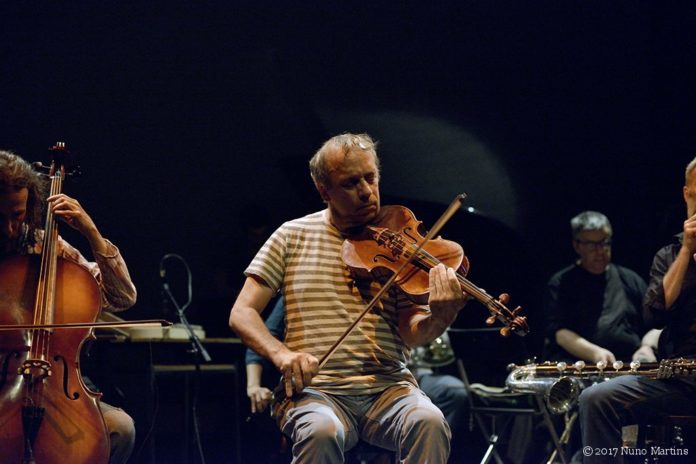Daniel Barbiero
Creative Sources Records, based in Portugal, was conceived in 1999 by violist/composer Ernesto Rodrigues as an outlet not only for his own work but for the kind of challenging, non-commercial music that appealed to him. The label originally released work by new music improvisers from Portugal and Spain, many but by no means all of them featuring Rodrigues. The label now issues work by musicians from both hemispheres and has put out fine performances not only by Rodrigues and his cellist son Guilherme, but also by Radu Malfatti, Mike Bullock, Axel Dörner, Ricardo Guerreiro, Gino Robair, Udo Schindler, Raed Yassin and many others.
Rodrigues came to adventurous improvisational music in the 1970s, a time when he listened to free jazz, the post-war avant-garde art music of Ligeti and Stockhausen, and the experimental work of Morton Feldman and John Cage. And one can hear in his music the influence of these latter two composers, particularly in the generally quiet dynamics and the ascendency of timbre over pitch that characterize much of his playing.
Although Creative Sources releases a diverse range of approaches to electro-acoustic improvisation, it does have an identifiable aesthetic. There are exceptions, of course, but an archetypal Creative Sources release will more likely than not contain sound art of refinement and restraint—qualities that summarize Rodrigues’ own playing quite well. In general the music texturally focused, developing gradually through nuanced shifts in shading, density and dynamics.
Several of Creative Sources’ recent releases serve as a good sampling of the label’s approaches to defining and exploring its particular aesthetic of improvisational sound art.
 Trees [cs252] brings together an unusual quintet of string trio—viola (Ernesto Rodrigues), cello (Guilherme Rodrigues) and double bass (Gianna de Toni)—with soprano saxophone (Christophe Berthet) and electric bass/objects (Raphael Ortis). The five tracks contain a deep range of sounds from all of the instruments: Sparse textures evoking creaking wood and the rustling of dry leaves (Ancient Trees); long bowed tones from the cello and double bass and suspended harmonics (Whistling Trees); rattling metal and pizzicato electric bass (Lonely Trees); low density layering and stillnesses (Moonlit Trees); siren-like sustained dissonances over a resonant, low foundation (Tree of Life).
Trees [cs252] brings together an unusual quintet of string trio—viola (Ernesto Rodrigues), cello (Guilherme Rodrigues) and double bass (Gianna de Toni)—with soprano saxophone (Christophe Berthet) and electric bass/objects (Raphael Ortis). The five tracks contain a deep range of sounds from all of the instruments: Sparse textures evoking creaking wood and the rustling of dry leaves (Ancient Trees); long bowed tones from the cello and double bass and suspended harmonics (Whistling Trees); rattling metal and pizzicato electric bass (Lonely Trees); low density layering and stillnesses (Moonlit Trees); siren-like sustained dissonances over a resonant, low foundation (Tree of Life). Contrasting with Trees’ relatively thick textures and dynamic ranges is the double CD Late Summer [cs230], with Ernesto Rodrigues, Radu Malfatti on trombone, and Rodrigues’ frequent collaborator Ricardo Guerreiro on computer. This is an extremely subtle set of music in two long tracks notable for their thorough-going porosity. The deliberate interstices between the musicians’ sounds leave significant and frequent points of entry for ambient sounds to seep in—bits of distant conversation, traffic, someone knocking at a door. Much of the music transpires in a liminal zone poised at the edge of hearing, and it’s almost a shock when a harmony briefly emerges from the trombone and viola.
Contrasting with Trees’ relatively thick textures and dynamic ranges is the double CD Late Summer [cs230], with Ernesto Rodrigues, Radu Malfatti on trombone, and Rodrigues’ frequent collaborator Ricardo Guerreiro on computer. This is an extremely subtle set of music in two long tracks notable for their thorough-going porosity. The deliberate interstices between the musicians’ sounds leave significant and frequent points of entry for ambient sounds to seep in—bits of distant conversation, traffic, someone knocking at a door. Much of the music transpires in a liminal zone poised at the edge of hearing, and it’s almost a shock when a harmony briefly emerges from the trombone and viola. All about Mimi [cs240] features another unusual lineup of instruments, with Rodrigues and Guerreiro once again on viola and computer, respectively, and Christian Wolfarth on cymbals. The cymbals often take the foreground role, appearing as a metallic shimmer over the serenely restrained underscore of unvoiced strings and understated electronics. Rodrigues’ viola here shows the timbral possibilities of a string instrument: Rough-edged white noise from heavily-pressured bowing, the pulse of unpitched circular bowing over muted strings, the percussive properties of the instrument tapped with bow or hand. The occasional assertion of a gong-like strike on the cymbals brings with it a dynamic contrast and a sense of discreet drama.
All about Mimi [cs240] features another unusual lineup of instruments, with Rodrigues and Guerreiro once again on viola and computer, respectively, and Christian Wolfarth on cymbals. The cymbals often take the foreground role, appearing as a metallic shimmer over the serenely restrained underscore of unvoiced strings and understated electronics. Rodrigues’ viola here shows the timbral possibilities of a string instrument: Rough-edged white noise from heavily-pressured bowing, the pulse of unpitched circular bowing over muted strings, the percussive properties of the instrument tapped with bow or hand. The occasional assertion of a gong-like strike on the cymbals brings with it a dynamic contrast and a sense of discreet drama.Finally, there is Flock [cs234] by the trio Great Waitress. These two long tracks are densely layered with long overlapping drones on accordion (Monica Brooks) and clarinet (Laura Altman) lying over the staccato interventions of prepared piano (Magda Mayas). The dynamics are generally robust, while the instruments’ individual timbres run toward the acute.








